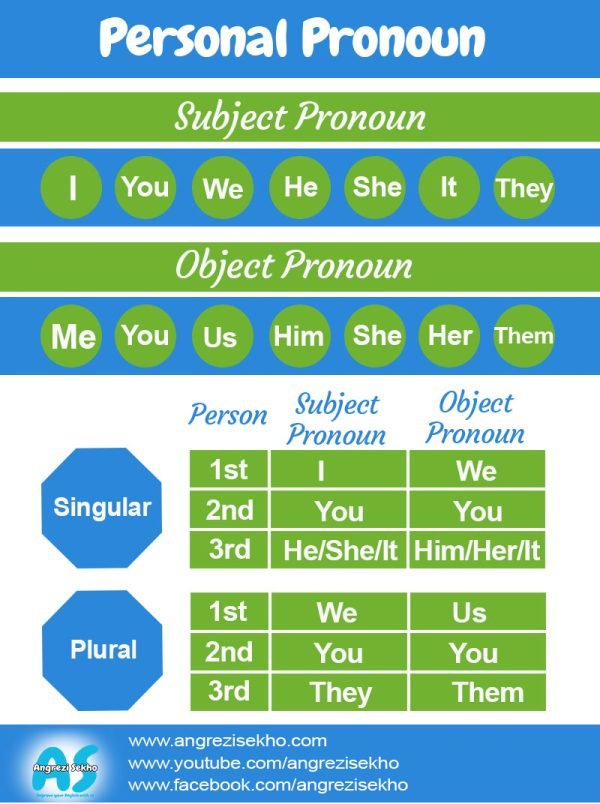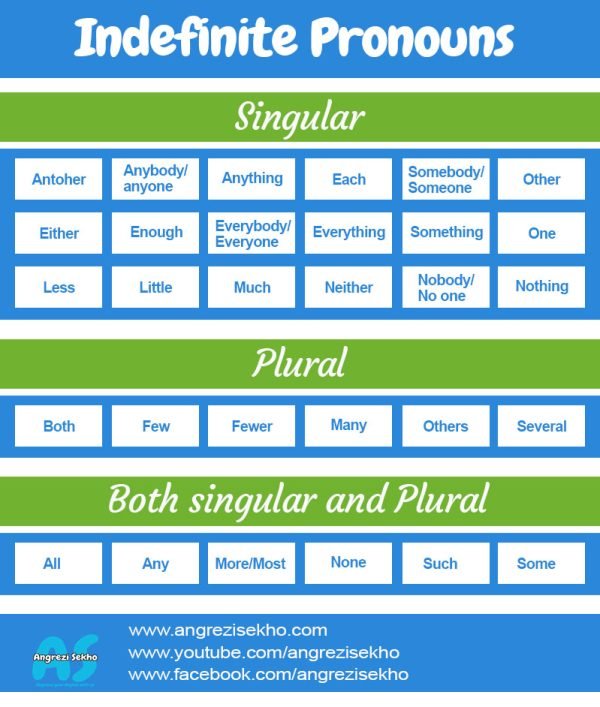What is Pronoun in Parts of Speech? Here you will learn Pronoun in Urdu with examples,
also you will learn all types of pronoun in English and Urdu.
وہ لفظ جو کسی ناؤن کی جگہ بولا جائے پرؤناؤن کہلاتا ہے۔یا اسکو اسمِ ضؐمیر بھی کہتےہیں۔
Pronoun Examples
Ali is a boy.
علی ایک لڑکا ہے
He is a boy.
وہ ایک لڑکا ہے
جو کسی نام کی جگہ بولا گیا ہے پروناؤن ہے۔Heدوسرے جملے میں
Kinds of Pronoun
There are nine kinds of Pronoun.
انگریزی میں پروناؤن کی نو قسمیں ہیں۔
1 – Personal Pronouns
2 – Demonstrative Pronouns
3 – Indefinite Pronouns
4 – Reflexive Pronouns
5 – Emphatic Pronouns
6 – Relative Pronouns
7 – Distributive Pronouns
8 – Possessive Pronouns
9 – Interrogative Pronouns
1 – Personal Pronouns
Personal Pronoun is used for the name of a person. He, She, It, They, etc.. are all examples of pronouns. They are called Personal Pronoun.
وہ پروناؤن جو کسی خاص شخص،جگہ یا ذات کےلئے استعمال کیا جائے پرسنل پروناؤن کہلاتا ہے۔
اس کی تین اقسام ہیں
1 – First Person
The person speaking is called the First Person.It maybe singular or plural. I, my and me use for singular and we, our, us use for plural.
بات کرنے والے شخص کو فرسٹ پرسن کہتے ہیں یا اسکو شخصی متکلم بھی کہتے ہیں۔یہ واحد یا جمع میں ہوتا ہے اگر واحد ہوتوآئی، مائی، می اور اگر جمع میں ہوتو اس کےلئے وی،آوراس کا استعمال کیا جاتا ہے۔
Example
I prepare my lecture daily.
میں اپنا لیکچر روزانہ تیار کرتا ہوں۔
He helps me.
وہ میری مدد کرتاہے۔
They helped us.
انہوں نے ہماری مدد کی۔
2 – Second Person
The person you are talking to is called the Second Person.It maybe singular or plural, as you, your.
جس شخص کے ساتھ بات کی جائےاسے سیکنڈ پرسن کہتے ہیں یا سے حاضر یا مخاطب بھی کہتے ہیں اور یہ واحد بھی ہوتا ہے ہواور جمع بھی اور ان کےلئے یو اور یور کا استعمال کیا جاتاہے۔
Example
This is your car.
یہ کار آپکی ہے۔
You are a teacher.
تم ایک استاد ہو۔
You are a girl.
تم یک لڑکی ہو۔
3 – Third Person
The person or thing to talk about is called Third Person. He, She, It use for singular and They, Their, Them use for plural.
جس شخص یا چیزکے بارے بات کی جائے اسے تھرڈ پرسن یا غائب کہتے ہیں اس میں واحد غائب کےلئے ہی شی اِٹ اور جمع غائب کےلئے دے،دیردیم کا استعمال کیا جاتاہے۔
Example
She is a girl.
وہ ایک لڑکی ہے۔
He is a man.
وہ ایک آدمی ہے۔
Its price twenty rupees.
اس کی قیمت 20 روپے ہے۔

2 – Demonstrative Pronouns
These Pronouns are used in place of nouns to witch they point is called Demonstrative Pronouns. (This, That, These and Those).
ایسے ضمیر جو کسی چیز کی طرف اشارہ کریں ضمائراشارہ کہلاتے ہیں۔
Example
This is a book.
یہ ایک کتاب ہے۔
Those are pens.
وہ قلم ہیں
These are my pens.
یہ میرے قلم ہیں۔
3 – Indefinite Pronouns
Indefinite Pronouns is a pronouns that refers to non specific persons or things. (another, anybody/ anyone, anything, each, either, enough, everybody/ everyone, everything, something , less , little)
ایسے پرناؤن جوکسی بھی عام شخص یا چیز کےلئے استعمال ہوں اور کسی خاص شخص یا چیز کا حوالہ نہ دیں یا جو کسی غیر معین اشیاء یا اشخاص کےلئے استعمال ہوں انہیں ضمائر تنکریہ کہتے ہیں۔
Example
Do good to others.
دوسرے کے ساتھ نیکی کرو۔
Few escaped unhurt.
چند ایک سلامت بچ گئے۔
Many of them were Pakistani.
ان میں سے بہت سے پاکستانی تھے۔

4 – Reflexive Pronouns
When a person or thing works on itself, these are called Reflexive Pronouns. (myself, yourself, himself, herself, itself, ourselves, yourselves, themselves.)
جب کوئی شخص یا چیز اپنے پر ہی کام کرے تو یہ ریفلیکسیو پروناؤن کہلاتے ہیں۔
Example
You hurt yourself.
تم نے اپنے آپکو زخمی کر لیا۔
We often deceive ourselves.
ہم اکثر اپنے آپکو دھوکا دیتے ہیں۔
You will hurt yourselves.
تم خود کو تکلیف دو گے۔
5 – Emphatic Pronouns
Emphatic Pronouns are used to lay emphasis on the subject of the sentence. (Myself, Herself, itself, Himself)
جب پروناؤن تاکیدی طور پر استعمال ہوں تو انکو تاکیدی پروناؤن کہتے ہیں اور یہ سبجیکٹ کے فوراُبعد استعمال ہوتے ہیں
Example
I myself said so.
میں نے خود یہ کہا۔
You will do it yourself.
تم یہ خود ہی کرو گے۔
I’ve seen myself doing this.
میں نے خود اسے یہ کرتے ہوئے دیکھا ہے۔
6 – Relative Pronouns
A Relative Pronoun is one that refers to a noun or pronoun, and joins two sentences. (who, whom, which, whose, that.)
جن کا تعلق ایسے اسم سے ہو جنکا ذکر پہلے ہو چکا ہو۔
Example
I know what you mean.
مجھے معلوم ہے تمہارا کہنے کیا مطلب ہے۔
He who hesitates loses.
جو سوچ میں پڑا و ہ گیا۔
I know the man who painted this picture.
میں اس شخص کو جانتا ہوں جس نے یہ تصویر پینٹ کی تھی۔
7 – Distributive Pronouns
Distributive Pronouns refer to persons and things one at a time. (Each, Either, Neither)
ایسے پروناؤن جو زیادہ اشیاء یااشخاص کو ظاہر کریں لیکن ایک وقت میں واحد کے معنی دیں۔
Example
Either of these books id O.K.
ان کتابوں میں سے کوئی ایک ٹھیک ہے۔
Either of you can go.
تم میں سے کوئی ایک جا سکتا ہے۔
Each of the boys has a book.
ہر ایک لڑکے کے پاس ایک کتاب ہے۔
8 – Possessive Pronouns
Mine, yours, his, hers, ours, yours, and theirs are called Possessive Pronouns and indicate ownership.
ایسے پروناؤن جو ملکیت کو ظاہرکریں۔
Example
This pen is mine.
یہ قلم میر ا ہے۔
These things are ours.
یہ چیزیں ہماری ہیں۔
That pen is yours.
وہ کتاب تمہاری ہے۔
9 – Interrogative Pronouns
Interrogative Pronouns are used for asking questions and they are used in place of the noun which we get in answer to the question.
ایسے پروناؤن جو سوال پوچھنے کےلئے استعمال ہوں
Example
Who broke this door?
یہ دروازہ کس نے توڑا؟
Whose is this pen?
یہ قلم کس کا ہے؟
Which would you prefer?
آپ کس کو ترجیح دیں گے؟
